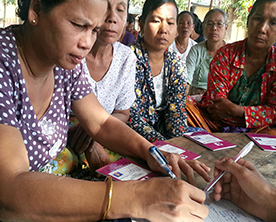The microfinance industry in Myan- mar was given a boost with the re- cent Responsible Finance Seminar: Laying the Foundations. Held on May 7-8 at the Summit Parkview Hotel in Yangon, the seminar covered issues and challenges faced by microfinance service providers. It was attended by almost a hundred participants from government agencies, microfinance institutions, technical service providers and international donor agencies operating in Myanmar.
The main session focused on risks en- countered by the industry not only in Myan- mar but globally as well. Among the risks discussed was, over-indebtedness – a risk faced by clients; and those faced by micro- finance institutions like credit risk, liquidi- ty, etc.; and the market environment which included competition and political interfer- ence.
The story of the Andhra Pradesh re- gion in India was presented as a case study. In this case the local government of inter- vened by closing a big microfinance institu- tion because of reports of suicides by clients who were over-indebted and subsequently this was reported in the newspapers. The action however resulted in the closure of the lending facility servicing low income groups and the loss of billions of dollars of uncol- lected loans. Although the institutions ini- tiated corrective measures, the struggle to gain back trust of the industry became a long uphill battle.
In Myanmar where microfinance is an emerging industry, ensuring that these risks will not be encountered is a concern. The financial sector of the country is presently dominated by banks and informal money lenders serving as the alternative for those who cannot access banks. Other sources of loan funds include pawnshops, cooperatives and agricultural input producers. In this context the development of microfinance institutions in Myanmar becomes relevant. Providing loans specifically to low-income groups through innovative methodologies like group lending and collateral substi- tutes allows a greater number of low-income people access to loans which can stimulate economic activity and increase household incomes.
With the passage of the microfinance law in 2012; almost 200 microfinance in- stitutions were immediately licensed. Some observers expressed that low entry require- ments and the fast licensing of the institu- tions may lead to abuse, like when savings are mobilized and not managed well. Also, policies like limitations on the individual loan amount and the interest rate cap might push institutions not to be transparent about their operations.
Succeeding sessions were centered on ensuring that microfinance institutions will not only be concerned with financial gains but remain consistent with its mission to alleviate low income groups. There are two campaigns to this end. The first is Social Per- formance Management (SPM), a mechanism that allows microfinance institutions to have “double bottom line” – the balance of hav- ing financial gains at the same time social gains. Furthermore, a set of Client Protec- tion Principles (CPP) are required to be ob- served by microfinance institutions so that clients will not be harmed by wrong policies or over indebtedness which may result when competing microfinance institutions flood a community with loan funds.
With LIFT, UNCDF, IFC and other donor agencies at the forefront of support- ing the development and maturity within the microfinance industry in Myanmar, other activities aimed at institutional capac- ity-building and enhancing the skills of the people running microfinance institutions is expected to develop the strong foundation of the industry in the country.










